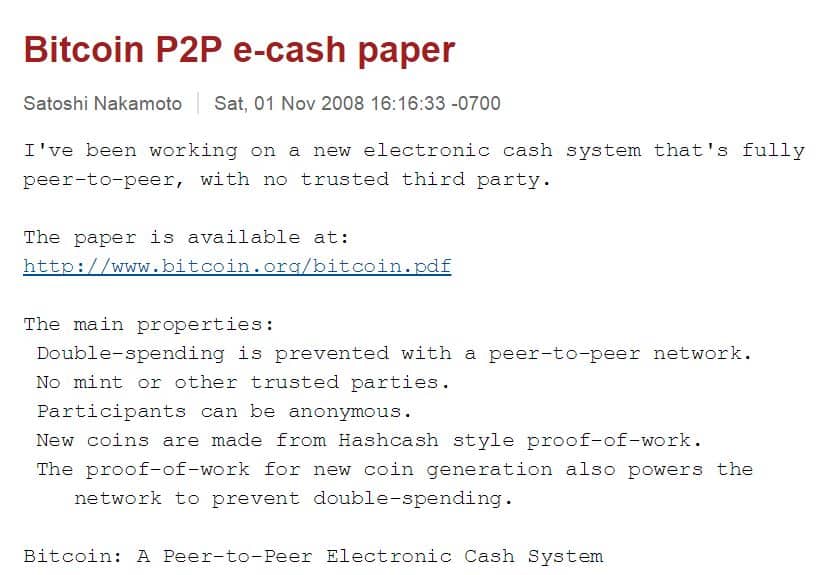Table of Contents
Satoshi Nakamoto
Satoshi Nakamoto is the inventor of Bitcoin and more importantly, it is underlying blockchain technology. No matter what the future price of Bitcoin the real treasure is blockchain technology. Hopefully, it is going to change the world as much as the internet did in the 1990s. Satoshi Nakamoto was nominated for a Nobel Prize in Economics. Moreover, he is a multi-billionaire. And yet no one knows what he looks like.
He may not even be a single person, and the name may serve as a cover for a group. Moreover, they could come together for the sake of starting a digital revolution. So today’s Biographics, we’re going to go over what we know about this little-known figure, as well as the theories behind his secret identity.

Satoshi Nakamoto Short Info
- The name Satoshi Nakamoto
- Born: 5 April 1975 (age 44) (claimed); Japan (claimed)
- Nakamoto’s initial email to Dai is dated 22 August 2008
How much is Satoshi Nakamoto worth?
After analyzing many symptoms many Crypto relevant people believed that Satoshi Nakamoto owns 1 million bitcoins. So approximately the current net worth is $2.6 billion.
What does Satoshi mean?
Now Satoshi indicates a small amount of Bitcoin units. That is recorded in the distributed ledger on blockchain technology. It is one hundred millionth of a single bitcoin (0.00000001 BTC). The respect of Bitcoin founder Satoshi Nakamoto, the Bitcoin unit name is Satoshi.
How much bitcoin does Satoshi Nakamoto have?
As per the public transaction log his known address owns 1,000,000 BTC. So, in 2017 when the Bitcoin price spike, Nakamoto BTC’s price was worth US$19 billion. It also indicated the possibility of the 44 richest men around the world.
Satoshi Nakamoto: The Mysterious Founder of Bitcoin
The identity of Bitcoin creator Satoshi Nakamoto, the enigmatic creator of Bitcoin, remains one of the greatest mysteries in the world of technology and finance. As the mastermind behind the first decentralized cryptocurrency, Nakamoto’s influence on the global financial system is undeniable. Despite being the owner of a substantial Bitcoin fortune, Nakamoto has chosen to remain anonymous, raising curiosity about his true identity and motives.
Satoshi Nakamoto Net Worth: How Rich Is He?
The net worth of Satoshi Nakamoto is a source of fascination. Nakamoto is estimated to own approximately 1.1 million Bitcoin (BTC), acquired through early mining efforts in 2009. As Bitcoin’s value fluctuates, so does his net worth. In 2024, when Bitcoin hit an all-time high of $73,700, Nakamoto’s holdings peaked at around $73 billion.
At the current market rate, his net worth positions him among the world’s wealthiest individuals, surpassing prominent tech and finance billionaires. However, none of Nakamoto’s Bitcoin has been moved or spent in over a decade, adding to the intrigue surrounding his fortune.
How Many Bitcoins Does Satoshi Nakamoto Hold?
It is widely believed that Nakamoto mined 1.1 million BTC, giving him control of about 5.6% of Bitcoin’s total supply. This calculation comes from analyzing the “Patoshi pattern,” identified by blockchain expert Sergio Demian Lerner. Nakamoto’s early mining efforts capitalized on Bitcoin’s initial block reward of 50 BTC, allowing him to accumulate a massive hoard before other miners entered the network.
Dorian Nakamoto: The Case of Mistaken Identity
In 2014, Dorian Satoshi Nakamoto, a California-based engineer, was mistakenly identified by Newsweek as the creator of Bitcoin. This misidentification led to a media frenzy and legal battles, with Dorian denying any involvement in Bitcoin’s development. The incident highlights the challenges of identifying the real Nakamoto and demonstrates the power of public fascination with the founder of Bitcoin.
The Impact of Satoshi Nakamoto’s Wealth on Bitcoin
Who invented bitcoin whose holdings pose a potential risk to the market? If these coins were ever sold or transferred, it could create significant volatility, given the size of his holdings. However, Nakamoto’s long-term inactivity has fostered stability and confidence within the crypto community.
Some speculate that Nakamoto’s decision not to spend or sell his Bitcoin reflects a commitment to decentralization, allowing Bitcoin to function without central authority. Others argue that the inactivity raises questions about whether Nakamoto is even alive.
Satoshi Nakamoto’s Legacy: Anonymity and Decentralization
Nakamoto’s choice to remain anonymous aligns with Bitcoin’s ethos of decentralization and privacy. His exit from the project in 2010 ensured that Bitcoin would evolve without a single controlling figure, reinforcing its decentralized nature.
Nakamoto’s anonymity also shields him from regulatory scrutiny and public pressure, further protecting Bitcoin’s core principles.
Satoshi Nakamoto wrote a paper For Blockchain Satoshi Nakamoto’s white paper

In October 2008, someone named Satoshi Nakamoto wrote a paper called “Bitcoin: A Peer-to-Peer Electronic Cash System”. He began to email all of the Cypherpunks, asking if they were willing to help him create his idea of a new system he developed called “Blockchain”.
This was a computer network that truly was peer-to-peer, without fear of interference from an Internet Service Provider ever shutting it down. The blockchain is an accounting system that records all transactions on a public ledger. Instead of the US Dollar, the value would be exchanged in a digital currency, called Bitcoin.
Every Bitcoin is generated by “mining” which is a mathematical problem-solving process. So at the end of problem-solving, they are rewarded with Bitcoin
In the beginning, one Bitcoin was only worth fractions of a penny. Back then, any run-of-the-mill computer you got on the shelf from Best Buy could handle mining Bitcoin. Also, anyone could receive and deposit the currency in their digital wallet.
Read the Satoshi Nakamoto Whitepaper
Initially Ignored Satoshi Nakamoto’s ideas
Even though it was the solution they had been searching for, many of the cypherpunks ignored Satoshi Nakamoto’s ideas. They weren’t kids anymore. They were now in their 40s and 50s, and they had already tried and failed to make their digital currencies.
The idea of Bitcoin was so radical, it seemed like something out of a science fiction movie. But one computer programmer from California named Hal Finney saw its potential, and he was the first person to take Satoshi Nakamoto seriously.
He agreed to work on The Bitcoin Project for free, and on January 3, 2009, Bitcoin was first launched. Hal Finney and Satoshi Nakamoto had never met face-to-face, and they never spoke over the phone. Nakamoto left his email address on the Bitcoin website, allowing anyone to contact him with any questions they may have about the project. This leads many other programmers to join in and help them.
In the very beginning, this idea was only popular with anarchists and libertarians who had the goal of living their lives free from government rule. While they are small in number, this community is still incredibly passionate about their philosophies to this very day. They were the first ones to cling to the “Bitcoin Revolution”, and many called Satoshi Nakamoto a hero.
Pirate Roberts And Silk Road
On The Run From the Law Of course, once the word got out Bitcoin was a way to transfer money privately. It was almost immediately adopted by criminals. In 2011, a website called The Silk Road appeared in a web browser called Tor, which is used to run the dark web. The founder and Kingpin of the Silk Road goes by the name of Dread Pirate Roberts.
You can buy anything on the Silk Road, including human slaves and hit orders from assassins. Most of this type of work is done by Cryptocurrency. In 2013, a 29-year-old man named Ross Ulbricht was arrested under suspicion of being The Dread Pirate Roberts.
In 2015, he was convicted of conspiracy to transfer narcotics, and he was labeled as an evil Kingpin. However, he was given not just one, but two life sentences, plus an additional 40 years, without the possibility of parole. The average Silk Road drug dealer only got 5 to 10 years behind bars.
Most people in the cryptocurrency community believe that Ulbricht was just a patsy and that the real Dread Pirate Roberts has gone free. The FBI seized Ross Ulbricht’s cache of Bitcoin and auctioned them off to the highest bidder.
Satoshi Nakamoto Leave Bitcoin Team
Either he had passed the account on to another Kingpin, or they truly did arrest the wrong man. Once Bitcoin started getting a lot of bad press, Satoshi Nakamoto was very upset to see how his project was being used for evil. The last known person to have communicated with Satoshi Nakamoto was Gavin Andresen, a programmer who looked up to Nakamoto as his mentor and hero.
When the FBI and CIA came looking for Satoshi Nakamoto, Gavin Andresen agreed to speak to them about Bitcoin on the mysterious founder’s behalf, because he wanted to help educate them about what blockchain technology is.
This must have frightened Nakamoto, because he completely cut off ties with the rest of the original Bitcoin team. Since then, Satoshi Nakamoto’s Bitcoin public wallet address has remained untouched.
Even in 2017, when the price rose to raise to $20,000 per coin, he has never withdrawn his money. He should be one of the richest men in the world, but he has decided not to spend a penny on it.
Cult of Satoshi

In the Cult of Satoshi, many of the leaders in traditional finance and tech are trying to figure out how to incorporate blockchain into the real world. So, there are the purists who still passionately believe in the anarchist ideals of the cypherpunks and Satoshi Nakamoto.
Many of these original followers were made multi-millionaires through their initial investments. While some of these people were coders who understood blockchain tech, the majority of them had no background in computer science at all and were supporting Bitcoin simply for the fact that they believed in the philosophy.
Is Satoshi Nakamoto CEO of Bitcoin
Satoshi Nakamoto was never the CEO of Bitcoin because it’s not even a business entity. He was never trying to be a leader, but the level of reverence that some people have for him has been compared to a cult on multiple occasions.
Without a leader to guide them, Bitcoin believers debate over the question: “What Would Satoshi Do?” They quote and analyze his old emails and publications. The Reddit boards are filled with heated debates trying to interpret Satoshi’s words as if it’s their Bible.
At this point, Bitcoin transactions take several hours, or even days to go through, and they cost roughly $40 in fees per transaction. It is almost as expensive and slows as the old-school banking system.
The idea that Bitcoin will be around forever is kind of like saying dial-up internet should still be around, too. Even though the tech has been in a serious downward spiral, and other companies like Ripple have drastically improved upon blockchain technology
Who is Possibly Satoshi Nakamoto?

Nick Szabo
David Chaum invented DigiCash in 1989, and he published an academic paper on the subject. Another one of the cypherpunks, Nick Szabo, created “Bit Gold”. All of these ideas were close, but no cigar. Even though the cypherpunks had this idea conceived, they couldn’t come up with a technical way to accomplish a true peer-to-peer experience. So Is Nick Szabo a Satoshi? That is a big question.
When you use the Internet, you are depending on your Internet Service Provider. Moreover, they need to abide by the laws of each respective country. Even with apps like PayPal and Venmo, sending money to your friends may seem like an instant peer-to-peer experience, at least for the customer. But behind the scenes, those companies still have to settle bank transactions the old-fashioned way.
This is 3 day’s worth of paperwork through an antiquated and expensive system, called SWIFT. If this sounds ridiculous in this day and age, that’s because it is. The global digital banking system has been long overdue for an overhaul. And after the 2008 stock market crash, the world was primed and ready for a financial revolution.

Hal Finney
They continue to have blind faith in the original Bitcoin, and in a man or group who isn’t even around anymore to give their input. The original programmer of Bitcoin, Hal Finney, suffered from ALS, also known as Lou Gehrig’s disease.
The timeline of Hal Finney’s condition getting worse lines up to when Satoshi Nakamoto decided to disappear. Andy Greenberg, a senior writer at WIRED magazine made that connection, and he believed that he had cracked the case, so he went to interview him.
At this point, Hal Finney was in a wheelchair, and he could no longer speak. He could only answer “yes” or “no” questions. Greenberg asked point-blank if he was the true Satoshi Nakamoto.
Finney’s eyes glistened in amusement, and he promptly responded, “No”. Even though Hal Finney had become a multi-millionaire from mining Bitcoin in the early days of the project, no amount of money could save him from the disease, but maybe he could postpone the inevitable.
On the brink of death, Finney requested that his body be cryogenically frozen, in hopes that someday, he would be unfrozen and given the cure for ALS. In 2014, he passed away, and his body was transported to a lab in Arizona. Just two miles away from Hal Finney’s home, the FBI showed up on someone’s property with a warrant.

Dorian Satoshi Nakamoto
They dragged out a man with black hair and glasses and arrested him under suspicion of being the mysterious founder of Bitcoin. He insisted over and over again that he had no idea what they were talking about.
His full legal name is Dorian Satoshi Nakamoto. Will the Real Satoshi Please Stand Up? After the paparazzi showed up, the news falsely reported that Dorian Satoshi Nakamoto was the true founder of Bitcoin. This sent him into the spotlight of the media, and he had to go on record with the Associated Press insisting that he did not have anything to do with the project and that someone had taken his name as a pseudonym.
Today, Dorian Nakamoto has been affectionately titled “The Fake Satoshi”, and members of the community love him. His face was even turned into a meme. Many people felt sorry that he was dragged into this, and even donated Bitcoins to him as a sort of “sorry for the mix-up” gift.
In 2017, those donations were inflated to be worth $273,000, and he quickly cashed out at just the right time. Today, Dorian Nakamoto has embraced the community, and he now enjoys being a celebrity and taking photos with his fans.

Dr. Craig Steven Wright
In 2015, yet another potential candidate emerged in the media. US authorities raided the home of an Australian man named Dr. Craig Wright. In 2016, Wright agreed to do multiple press interviews claiming that he was the real Satoshi Nakamoto.
Most people don’t know how easy it is to fake this kind of proof on the blockchain. So it has been published in multiple venues that he is the real Satoshi Nakamoto. But after seeing the likes of the BBC and The Economist vouching for him, many people in the Cult of Satoshi began to believe that their Messiah had returned. And he was back to tell them exactly what to do with their money.
Vitalik Buterin Speech
During a public interview, boy genius Vitalik Buterin gave several examples of what Craig Wright could have faked. He gave examples about publically proving that he was the real Satoshi Nakamoto, and yet he failed to do so.
Buterin said, “Signaling theory says that if you have a good way to prove something and you have a noisy way to do it, then the reason why you picked the noisy way was that you couldn’t do it the good way in the first place.”. Craig Wright is profiting off of his sudden claim to fame.
He is an outspoken showman, appearing before crowds and making promises about Bitcoin’s future. In reality, he has started his own company, and the promises he makes are not that impressive where the tech is concerned. He made millions of dollars from investors, simply by claiming that he is Satoshi Nakamoto.
Wizard of Oz
In February of 2018, Craig Wright was sued for stealing $10 Billion of cryptocurrency assets from his former business partner. The lawsuit is still ongoing, so at the time we are writing this article, we still can’t be sure of the outcome.
A journalist named Andrew O’Hagan has done a very deep dive into the Craig Wright case. He has discovered that Wright also lost a lot of money in the past from a cryptocurrency firm called Liberty Reserve in Costa Rica. Wright also met face-to-face with Ross Ulbricht soon before his arrest.
So why on Earth would this millionaire businessman be associating with a drug dealer from the Silk Road? Some people theorize that Wright isn’t Satoshi Nakamoto at all, and he may be the true Dread Pirate Roberts.
Final Thought Of Satoshi Nakamoto
The Future of Blockchain, and Remaining Theories, there are dozens of theories of who Satoshi Nakamoto truly is. One of Musk’s former interns at SpaceX, Sahil Gupta, wrote a comprehensive blog post on Medium as to why he believed his former boss was the real Satoshi Nakamoto.
This caused such a stir, that Elon Musk had to tweet that he was not the founder of Bitcoin. Everyone has a very passionate reason for believing their theory is the correct one, of course. Whoever he is, we may have never seen Satoshi Nakamoto in the news at all, even under another name.
It’s very possible that he knew better than to put himself in the limelight. Moreover, it would be impossible to even guess his identity. But if Satoshi Nakamoto is still alive, and if he truly is just one man or a group of people, why haven’t they touched those billions of dollars in years?
Is there a person on this planet with the willpower to resist that kind of temptation? And what does he think about this corrupt system that Bitcoin has become?
Mike Hearn And Nakamoto
In 2012, Satoshi Nakamoto wrote in an email to one of the original core developers of Bitcoin. Mike Hearn, “Ripple is interesting in that it’s the only other system that does something with trust besides concentrating it into a central server.”. It is the only alternative coin to Bitcoin.
In his last email, he also wrote that he had given up on Bitcoin, and wanted to work on “another project”. Without giving any details as to what that new project was.

David Schwartz
This leads us to our final theory: David Schwartz, who is now the lead cryptographer at Ripple. In 1988, Schwartz filed a patent for a distributive computer network before the existence of the Internet. In a lot of ways, his idea was almost identical to Bitcoin 20 years before Satoshi Nakamoto appeared on the scene.
Schwartz is no stranger to using aliases, either. He went by the pseudonym “Joel Katz” online for years. There is no denying that he was intelligent enough to come up with this on his own. Schwartz has used his knowledge to turn the Ripple ecosystem into a far more sustainable product than Bitcoin ever was.
Conclusion
Satoshi Nakamoto’s influence on the world of finance remains unparalleled. With a net worth potentially exceeding $73 billion, Nakamoto could be among the richest people on Earth, yet his coins remain untouched. The mystery of his identity, coupled with his extraordinary wealth, fuels ongoing speculation and curiosity.
As Bitcoin continues to grow, so does the legend of Satoshi Nakamoto. Whether he will ever reveal himself, move his Bitcoin holdings, or remain a ghost in the digital wilderness is a question that may never be answered. For now, Nakamoto’s anonymity and his contribution to the creation of Bitcoin leave an indelible mark on the history of finance.

